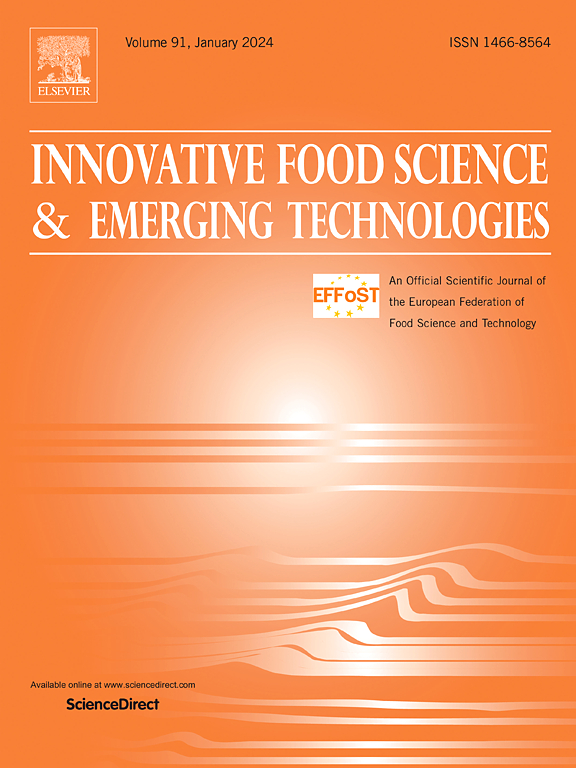Effects of ohmic heating on interfacial, rheology and structure of aquafaba proteins and products
IF 6.3
1区 农林科学
Q1 FOOD SCIENCE & TECHNOLOGY
Innovative Food Science & Emerging Technologies
Pub Date : 2025-06-06
DOI:10.1016/j.ifset.2025.104081
引用次数: 0
Abstract
Aquafaba, the viscous liquid obtained from cooking chickpeas, has emerged as a promising plant-based egg white substitute due to its foaming and emulsifying abilities. However, its native functional performance remains limited by low protein content and structural instability, which compromises its use in food systems such as meringues. This study aimed to evaluate ohmic heating (OH) as a clean-label and sustainable strategy to improve the functional properties of chickpea aquafaba, focusing on its structural, physicochemical, and rheological changes under different electric field intensities (20–50 V·cm−1). OH at 20 V·cm−1 significantly enhanced protein solubility (from 32.6 % to 46.4 %), increased free sulfhydryl content by 61 %, and improved viscoelastic moduli (G' and G") by over 35 %, resulting in denser, more elastic foams. Meringue porosity was reduced from 21.35 % (control) to 6.47 %, indicating a stronger structure. Conversely, higher intensities (≥ 40 V·cm−1) led to excessive protein denaturation, reducing solubility by 47 %, increasing porosity to 33.61 %, and decreasing meringue cutting force from 7.76 N to 2.98 N. These results demonstrate that moderate OH intensity is effective in modulating protein structure to improve foam stability. The application of OH to aquafaba is unprecedented and represents a novel strategy to enhance plant-based protein systems for clean-label and sustainable food products.
欧姆加热对水藻蛋白及其制品的界面、流变学和结构的影响
Aquafaba是一种从鹰嘴豆中提取的粘性液体,由于其发泡和乳化能力,已经成为一种很有前途的植物蛋白替代品。然而,它的天然功能性能仍然受到蛋白质含量低和结构不稳定的限制,这影响了它在蛋白酥皮等食品系统中的使用。本研究旨在评价欧姆加热(OH)作为一种清洁标签和可持续的策略来改善鹰嘴豆水豆浆的功能特性,重点研究了不同电场强度(20-50 V·cm−1)下鹰嘴豆水豆浆的结构、物理化学和流变学变化。20 V·cm−1的OH显著提高了蛋白质溶解度(从32.6%提高到46.4%),游离巯基含量提高了61%,粘弹性模量(G'和G")提高了35%以上,从而使泡沫更致密、更有弹性。蛋白蛋白孔隙度由21.35%(对照)降至6.47%(对照),结构较强。相反,较高的OH强度(≥40 V·cm−1)会导致蛋白质过度变性,溶解度降低47%,孔隙率增加到33.61%,蛋白蛋白切割力从7.76 N降低到2.98 N。这些结果表明,中等OH强度可以有效调节蛋白质结构,提高泡沫稳定性。OH在aquafaba中的应用是前所未有的,代表了一种新的策略,以增强植物蛋白系统的清洁标签和可持续食品。
本文章由计算机程序翻译,如有差异,请以英文原文为准。
求助全文
约1分钟内获得全文
求助全文
来源期刊
CiteScore
12.00
自引率
6.10%
发文量
259
审稿时长
25 days
期刊介绍:
Innovative Food Science and Emerging Technologies (IFSET) aims to provide the highest quality original contributions and few, mainly upon invitation, reviews on and highly innovative developments in food science and emerging food process technologies. The significance of the results either for the science community or for industrial R&D groups must be specified. Papers submitted must be of highest scientific quality and only those advancing current scientific knowledge and understanding or with technical relevance will be considered.

 求助内容:
求助内容: 应助结果提醒方式:
应助结果提醒方式:


